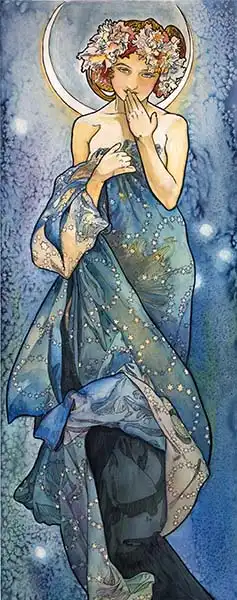Moon
"Luna" is an oil painting by the Czech artist
Alfons Mucha , who was an important representative of the
Art Nouveau and Art Nouveau art movements. This painting is part of Mucha's series called "The Moon" (also known as "The Nightingale Moon"). This series includes paintings that represent different months and feature female figures associated with them. "Luna" represents the moon.
In the center of the picture is shown a female figure who personifies the moon (Luna). The figure is elegant and beautiful, typical of Mucha's work. Luna is dressed in beautiful art nouveau clothing, and her hair is long and wavy. Luna has traditionally been associated in art with the moon and the night light. In this image, Luna holds the moon as a luminous disc in her hands, emphasizing this symbolism.
Mucha's artistic style, which is typical of Art Nouveau, includes frequent use of floral and organic motifs. In the background of the painting you can see patterns of
flowers and plants, which are characteristic of the Art Nouveau artistic movement. The composition of the image is symmetrical and harmonious. The figure of Luna is placed in the center, which gives her importance and emphasis.
Prevailing color of this fine art print is blue and its shape is tall. This image is printed on demand - you can choose material, size and finishing.
Alphonse Maria Mucha (1860-1939) Czech
Art Nouveau painter. Born in Ivančice, he studied high school in Brno and initially made his living painting backdrops. After 1879, he shortly lived in Vienna, where he expanded his artistic education. After a fire in his employer’s company, he was forced to return to Moravia. He did not stay long, and already in 1887 moved to Paris to continue his studies at the Académie Julian and Académie Colarossi. It was at this time that he worked on the production of advertising posters (
Monaco, Monte Carlo. Among hist most famous works are posters for famous Parisian actress Sarah Bernhardt. She was so happy with the result that she signed a contract for six years with Mucha. In 1906 in Prague, Mucha married Marie Chytilová. Together, they visited the United States, where he met with his new patron millionaire Charles R. Crane. After returning to the Czech Republic, he settled in Prague. When Czechoslovakia gained independence, he designed postage stamps, banknotes and other documents for the new state. He created a series of paintings depicting
Four seasons. From 1891 he worked on his masterpiece, Slav Epic - a series of twenty huge paintings, tracing the history of the Slavs, which he dedicated in 1928 to Prague. These were stored between the years 1963-2012 at the chateau in Moravsky Krumlov. In 2012, they were transferred to the National Gallery in the Trade Fair Palace. Alfons Mucha died on July 14, 1939 to pneumonia, after his arrest and interrogation by the Gestapo. He is buried at Vyšehrad cemetery.


